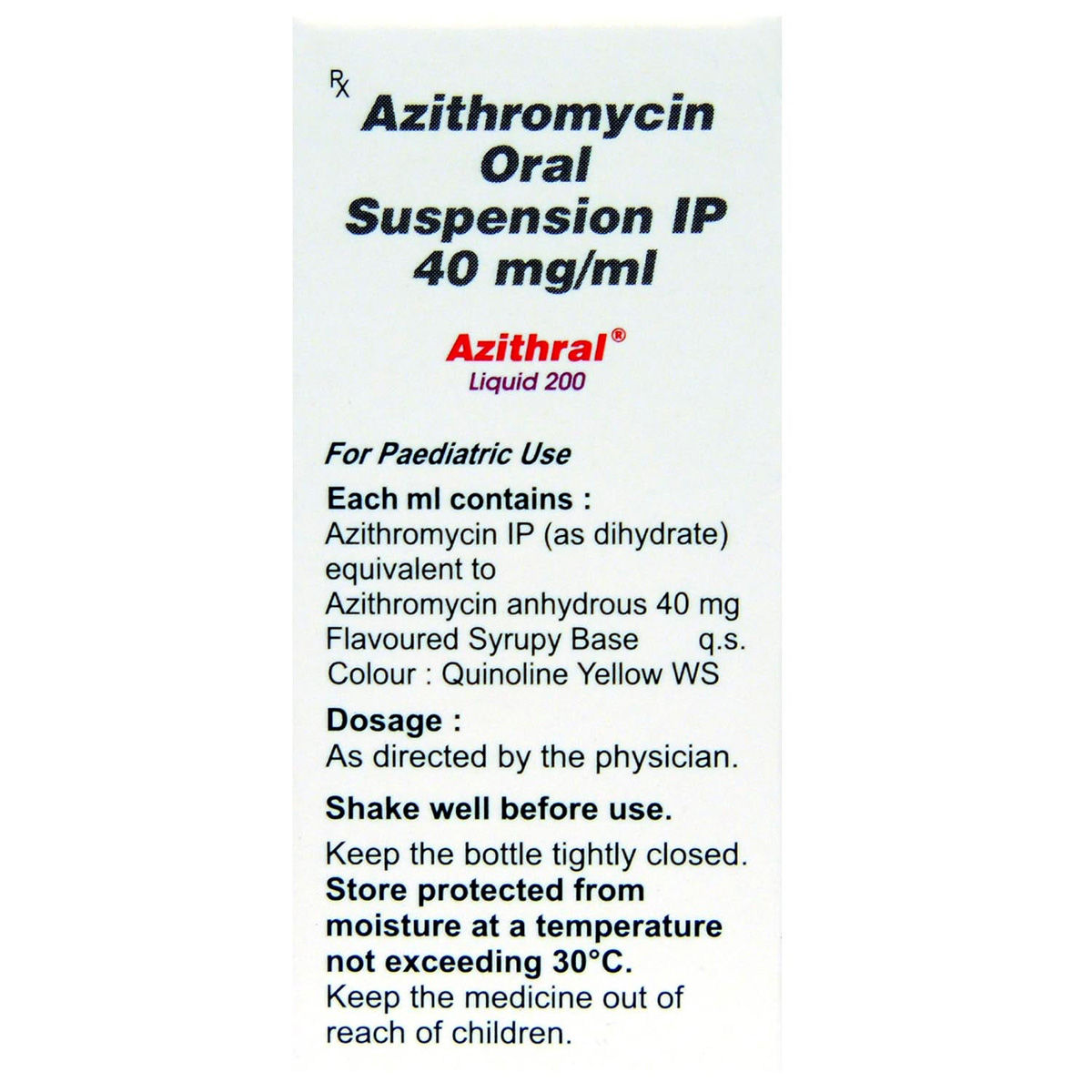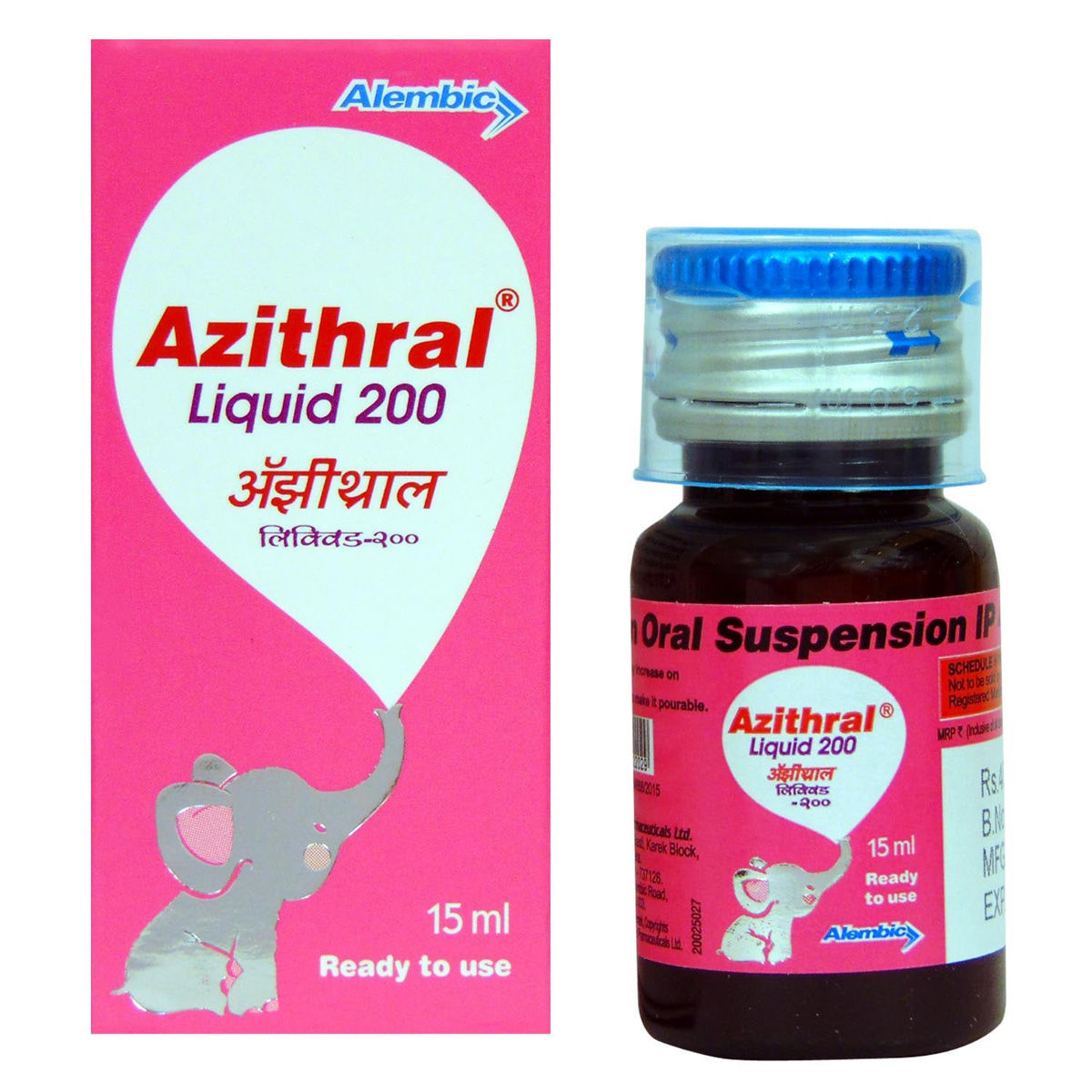Azithral 200 Liquid 15 ml







₹51.3*
MRP ₹57
10% off
₹48.45*
MRP ₹57
15% CB
₹8.55 cashback(15%)
Free Delivery
With Circle membership
(Inclusive of all Taxes)
This offer price is valid on orders above ₹800. Apply coupon PHARMA10/PHARMA18 (excluding restricted items)
Know Your Delivery Time
Provide Delivery Location
Available Offers

Secure Payment

India's Most Trusted Pharmacy

Genuine Products
Composition :
Manufacturer/Marketer :
Consume Type :
Return Policy :
Expires on or after :
About Azithral 200 Liquid
Azithral 200 Liquid is used to treat several bacterial infections of the upper/lower respiratory tract, middle ear, skin and soft tissue. A bacterial infection is a condition in which harmful bacteria grow in the body and cause infection. It can infect any part of the body and multiply very quickly. Azithral 200 Liquid does not work against infections caused by a virus.
Azithral 200 Liquid contains Azithromycin, which works by inhibiting the production of essential proteins that are necessary for bacteria to grow, multiply and increase in numbers. Thus, it prevents the growth of bacteria.
Give Azithral 200 Liquid to your child as prescribed by the doctor. Azithral 200 Liquid may cause common side effects such as diarrhoea, vomiting, headache, nausea or stomach pain. Most of these side effects of Azithral 200 Liquid do not require medical attention and gradually resolve over time. However, if the side effects persist or worsen, please consult your doctor.
If your child is allergic to Azithromycin or other medicines, please tell the doctor. Azithral 200 Liquid should be used only in doses prescribed by a doctor for children. It is recommended that you complete the full course of Azithral 200 Liquid as prescribed by the doctor, even if your child feels better after a few days.
Uses of Azithral 200 Liquid
• Respiratory Tract Infections: Azithral 200 Liquid helps treat infections in the lungs, throat, and airways.
• Skin and Soft Tissue Infections: Azithral 200 Liquid is effective against bacterial infections affecting the skin and underlying tissues.
• Eyes, Ear and Sinus Infections: Azithral 200 Liquid helps in managing bacterial infections in the eyes, ears and sinuses.
• Pneumonia: Azithral 200 Liquid is prescribed for treating pneumonia caused by bacterial infections.
• Urinary Tract Infections: Azithral 200 Liquid is used to treat bacterial infections in the urinary tract.
• Infections in Immunocompromised Patients: Azithral 200 Liquid helps prevent infections in individuals with weakened immune systems.
Directions for Use
- Azithral 200 Liquid can be given to your child with or without food.
- It is usually given once daily at the same time each day.
- However, follow the doctor's instructions regarding the dosage and timing of this medication to ensure effectiveness.
- Shake the bottle well before each use.
- Give the prescribed dose to your child by mouth using the measuring cup provided with the pack.
- Avoid using regular household spoons, as they may not measure the dose correctly
Medicinal Benefits
Azithral 200 Liquid belongs to a class of medications called antibiotics. It contains Azithromycin, which is used to treat several bacterial infections in children. Azithromycin inhibits the production of essential proteins that are necessary for bacteria to grow, multiply, and increase in number.
How Azithral 200 Liquid Works
Storage
- Inform Your Doctor: Notify your doctor immediately about your diarrhoea symptoms. This allows them to adjust your medication or provide guidance on managing side effects.
- Stay Hydrated: Drink plenty of fluids to replace lost water and electrolytes. Choose water, clear broth, and electrolyte-rich drinks. Avoid carbonated or caffeinated beverages to effectively rehydrate your body.
- Follow a Bland Diet: Eat easy-to-digest foods to help firm up your stool and settle your stomach. Try incorporating bananas, rice, applesauce, toast, plain crackers, and boiled vegetables into your diet.
- Avoid Trigger Foods: Steer clear of foods that can worsen diarrhoea, such as spicy, fatty, or greasy foods, high-fibre foods, and dairy products (especially if you're lactose intolerant).
- Practice Good Hygiene: Maintain good hygiene to prevent the spread of infection. To stay healthy, wash your hands frequently, clean and disinfect surfaces regularly, and avoid exchanging personal belongings with others.
- Take Anti-Diarrheal Medications: If your doctor advises, anti-diarrheal medications such as loperamide might help manage diarrhoea symptoms. Always follow your doctor's directions.
- Keep track of your diarrhoea symptoms. If they don't get better or worse or are accompanied by severe stomach pain, blood, or dehydration signs (like extreme thirst or dark urine), seek medical help.
- Inform your doctor about the nausea and discuss possible alternatives to the medication or adjustments to the dosage.
- Divide your daily food intake into smaller, more frequent meals to reduce nausea.
- Opt for bland, easily digestible foods like crackers, toast, plain rice, bananas, and applesauce.
- Avoid certain foods that can trigger nausea, such as fatty, greasy, spicy, and smelly foods.
- Drink plenty of fluids, such as water, clear broth, or electrolyte-rich beverages like coconut water or sports drinks.
- Use ginger (tea, ale, or candies) to help relieve nausea.
- Get adequate rest and also avoid strenuous activities that can worsen nausea.
- Talk to your doctor about taking anti-nausea medication if your nausea is severe.
- Record when your nausea occurs, what triggers it, and what provides relief to help you identify patterns and manage your symptoms more effectively.
- Drink water or other clear fluids.
- To prevent worsening of pain, limit intake of tea, coffee, or alcohol.
- Include bland foods like rice, toast, crackers, and rice in your diet.
- Avoid lying down immediately after eating as it may cause indigestion or heartburn.
- Avoid acidic and spicy food as it may cause indigestion.
- Inform Your Doctor: Notify your doctor immediately about your diarrhoea symptoms. This allows them to adjust your medication or provide guidance on managing side effects.
- Stay Hydrated: Drink plenty of fluids to replace lost water and electrolytes. Choose water, clear broth, and electrolyte-rich drinks. Avoid carbonated or caffeinated beverages to effectively rehydrate your body.
- Follow a Bland Diet: Eat easy-to-digest foods to help firm up your stool and settle your stomach. Try incorporating bananas, rice, applesauce, toast, plain crackers, and boiled vegetables into your diet.
- Avoid Trigger Foods: Steer clear of foods that can worsen diarrhoea, such as spicy, fatty, or greasy foods, high-fibre foods, and dairy products (especially if you're lactose intolerant).
- Practice Good Hygiene: Maintain good hygiene to prevent the spread of infection. To stay healthy, wash your hands frequently, clean and disinfect surfaces regularly, and avoid exchanging personal belongings with others.
- Take Anti-Diarrheal Medications: If your doctor advises, anti-diarrheal medications such as loperamide might help manage diarrhoea symptoms. Always follow your doctor's directions.
- Keep track of your diarrhoea symptoms. If they don't get better or worse or are accompanied by severe stomach pain, blood, or dehydration signs (like extreme thirst or dark urine), seek medical help.
- Tell your doctor about your GAS symptoms. They may change your medication regimen or prescribe additional drugs to help you manage them.
- To manage GAS symptoms, eat a balanced diet of fibre, vegetables, and fruits.
- Drink enough water throughout the day to avoid constipation and treat GAS symptoms.
- Regular exercise like yoga and walking may help stimulate digestion and alleviate GAS symptoms.
- Take probiotics only if your doctor advises, as they may help alleviate GAS symptoms by promoting gut health.
- Take medication for GAS symptoms only if your doctor advises, as certain medications can interact with your existing prescriptions or worsen symptoms.
- If symptoms persist, worsen, or are accompanied by severe abdominal pain, vomiting, or bleeding, seek immediate medical attention.
- Avoid taking raw fruits, nuts and vegetables.
- Do not share your personal things with others like toothbrushes.
- Clean the wounds and cuts using soap and water.
- Wash your hands thoroughly and frequently and maintain hygiene.
- Get a good quality of sleep.
- Preventing Vomiting (Before it Happens)
- Take medication exactly as prescribed by your doctor. This can help minimize side effects, including vomiting.
- Having a small meal before taking your medication can help reduce nausea and vomiting.
- Talk to your doctor about taking anti-nausea medication along with your prescribed medication.
- Managing Vomiting (If it Happens)
- Try taking ginger in the form of tea, ale, or candy to help alleviate nausea and vomiting.
- What to Do if Vomiting Persists
- Consult your doctor if vomiting continues or worsens, consult the doctor for guidance on adjusting your medication or additional treatment.
What if I have taken an overdose of Azithral 200 Liquid
Drug Warnings
If your child is allergic to Azithromycin or other medicines, please tell the doctor. Azithral 200 Liquid should be used only in doses prescribed by a doctor for children. You are recommended to complete the full course of Azithral 200 Liquid as prescribed by the doctor, even if your child feels better after a few days.
Drug-Drug Interactions
Drug-Drug Interactions
Login/Sign Up
Co-administration of Azithral 200 Liquid 15 ml with Ziprasidone can increase the risk of irregular heart rhythm.
How to manage the interaction:
Although there is an interaction between Ziprasidone and Azithral 200 Liquid 15 ml but can be taken together if prescribed by a doctor. Contact a doctor immediately if you experience sudden dizziness, lightheadedness, fainting, shortness of breath. Do not discontinue any medications without consulting a doctor.
Taking Azithral 200 Liquid 15 ml with Ivabradine increases the risk of an abnormal heart rhythm.
How to manage the interaction:
Though administration of Azithral 200 Liquid 15 ml alongside Ivabradine can result in an interaction, it can be taken if a doctor has advised it. However, if you experience sudden dizziness, lightheadedness, fainting, shortness of breath, or rapid heartbeat, get medical treatment immediately. Do not discontinue any medications without consulting a doctor.
Coadministration of Azithral 200 Liquid 15 ml with nilotinib can increase the risk or severity of irregular heart rhythms. The risk increases in patients with a history of heart illness or electrolyte imbalance.
How to manage the interaction:
Although administration of Azithral 200 Liquid 15 ml alongside nilotinib can result in an interaction, it can be taken if a doctor has advised it. However, if you experience sudden dizziness, breathing difficulty, or rapid heartbeat, consult the doctor immediately. Do not stop any medications without a doctor's advice.
Taking Azithral 200 Liquid 15 ml with leflunomide can cause liver problems.
How to manage the interaction:
Although there is an interaction between Azithral 200 Liquid 15 ml and leflunomide, they can be taken together if prescribed by a doctor. However, consult a doctor if you experience fever, chills, joint pain or swelling, unusual bleeding or bruising, skin rash, itching, less desire to eat, fatigue, nausea, vomiting, abdominal pain, and/or yellowing of the skin or eyes. Do not discontinue any medications without consulting a doctor.
Taking Azithral 200 Liquid 15 ml with anagrelide may increase the risk of an abnormal heart rhythm. If you're dealing with other cardiac illnesses, electrolyte imbalances (for example, magnesium or potassium loss likely due to serious or prolonged diarrhoea or vomiting), you may be at greater risk.
How to manage the interaction:
Although using Azithral 200 Liquid 15 ml and anagrelide together can possibly result in an interaction, it can be taken if your doctor has advised it. However, if you experience sudden dizziness, lightheadedness, fainting, breathing difficulty, or rapid heartbeat, consult the doctor immediately. Do not stop any medications without a doctor's advice.
Taking Azithral 200 Liquid 15 ml with iloperidone increases the risk of an abnormal heart rhythm.
How to manage the interaction:
Though administration of Azithral 200 Liquid 15 ml alongside iloperidone can result in an interaction, it can be taken if a doctor has advised it. However, if you experience sudden dizziness, lightheadedness, fainting, shortness of breath, or rapid heartbeat, get medical treatment immediately. Do not discontinue any medications without consulting a doctor.
Taking Azithral 200 Liquid 15 ml with citalopram may increase the risk of an abnormal heart rhythm.
How to manage the interaction:
Although using Azithral 200 Liquid 15 ml alongside citalopram can result in an interaction, it can be taken if a doctor has advised it. However, if you experience sudden dizziness, lightheadedness, fainting, breathing difficulty, or rapid heartbeat, consult the doctor immediately. Do not stop any medications without a doctor's advice.
Coadministration of Azithral 200 Liquid 15 ml with colchicine may raise colchicine levels in the blood to undesirable levels.
How to manage the interaction:
Concomitant administration of Azithral 200 Liquid 15 ml alongside colchicine can result in an interaction, but it can be taken if a doctor has advised it. Inform your doctor if you have any of the following symptoms: stomach discomfort, nausea, vomiting, diarrhea, fever, muscular pain, weakness, exhaustion, and/or numbness or tingling in your hands and feet. Do not discontinue any medications without consulting a doctor.
Taking Azithral 200 Liquid 15 ml with vandetanib increases the risk of an abnormal heart rhythm. If you're dealing with other cardiac illnesses, electrolyte imbalances (for example, magnesium or potassium loss likely due to serious or prolonged diarrhoea or vomiting), you may be at greater risk.
How to manage the interaction:
Although administration of Azithral 200 Liquid 15 ml alongside vandetanib can possibly result in an interaction, it can be taken if your doctor has advised it. However, if you experience sudden dizziness, lightheadedness, fainting, breathing difficulty, or rapid heartbeat, consult the doctor immediately. Do not stop any medications without a doctor's advice.
Taking Azithral 200 Liquid 15 ml with gatifloxacin may increase the risk of an abnormal heart rhythm.
How to manage the interaction:
Though administration of Azithral 200 Liquid 15 ml alongside gatifloxacin can result in an interaction, it can be taken if a doctor has advised it. However, if you experience sudden dizziness, lightheadedness, fainting, breathing difficulty, or rapid heartbeat, consult the doctor immediately. Do not stop any medications without a doctor's advice.
Drug-Food Interactions
Drug-Food Interactions
Login/Sign Up
Diet & Lifestyle Advise
- Give probiotics after completing the full course to restore some healthy bacteria in the intestines that may have been killed.
- Probiotics after antibiotic treatment can reduce the risk of antibiotic-associated diarrhoea. Certain fermented foods like cheese, yoghurt, kombucha, sauerkraut, and kimchi can help to restore the good bacteria of the intestine. Include fibre-rich foods, as they can be easily digested by gut bacteria, which helps stimulate their growth. Thus, fibre-rich foods may help restore healthy gut bacteria after a course of antibiotics.
- Make sure your child drinks plenty of water or other fluids every day.
Habit Forming
Therapeutic Class
Azithral 200 Liquid Substitute

Azithral Dry Syrup 7.5 ml
by AYUR
₹3.67per tabletZithrobact 200 Liquid 15 ml
by Others
₹3.80per tablet
Product Substitutes
Alcohol
Not applicable
-
Pregnancy
Not applicable
-
Breast Feeding
Not applicable
-
Driving
Not applicable
-
Liver
Consult your doctor
If your child is suffering from liver disease, inform your doctor before using Azithral 200 Liquid.
Kidney
Consult your doctor
If your child is suffering from kidney disease, inform your doctor before using Azithral 200 Liquid.
Children
Safe if prescribed
Azithral 200 Liquid should be used for children in dose and duration as advised by the doctor.

Have a query?
FAQs
Azithral 200 Liquid is used to treat bacterial infections of the upper/lower respiratory tract, middle ear, skin and soft tissue.
Azithral 200 Liquid contains Azithromycin which works by inhibiting the production of essential proteins that are necessary for bacteria to grow, multiply and increase in numbers. Thus, it prevents the growth of bacteria.
Azithral 200 Liquid is not used to treat viral infections. Azithral 200 Liquid is an antibiotic which is used to treat only bacterial infections.
You are not recommended to stop giving Azithral 200 Liquid to your child without consulting the doctor as it may worsen the condition or cause recurring symptoms. Therefore, use Azithral 200 Liquid for as long as your doctor has prescribed it, and if your child experiences any difficulty while taking Azithral 200 Liquid, please consult your doctor.
Azithral 200 Liquid is used to treat bacterial infections. It does not treat fever, therefore, consult a doctor if your child has a fever. The doctor will prescribe suitable medicines to treat the child’s condition.
Azithral 200 Liquid helps treat throat infections such as tonsillitis (inflammation of tonsils) and sore throat. Hence, it can be given to the child for treating throat infections if prescribed by the doctor.
If too much of Azithral 200 Liquid is administered to the child they may feel unwell. Contact the doctor immediately if and take any remaining medicine with you.
Common side effects of Azithral 200 Liquid include diarrhoea, vomiting, headache, nausea or stomach pain. Most of these side effects may not require medical attention and gradually resolve over time. However, if the side effects persist or worsen, please consult your doctor.
Azithral 200 Liquid may cause serious side effects like severe or prolonged diarrhoea, severe skin rash, low blood pressure, serious skin reactions, rapid or irregular heartbeat, difficulty breathing, sudden wheezing, itching, and swelling of the face.
In some cases, using other medicines at the same time as Azithral 200 Liquid may cause interactions. Therefore, consult the doctor if you are giving any other medicines to the child during treatment with Azithral 200 Liquid.
Azithral 200 Liquid may not affect how your child’s body responds to vaccines. However, it is advised to consult the doctor if the child is due to undergo any vaccination whilst on treatment with Azithral 200 Liquid.
The doctor may recommend kidney and liver function tests if the child is on long-term treatment with Azithral 200 Liquid.
Azithral 200 Liquid may cause indigestion as a side effect and affect the child’s digestion. Include fibre-rich foods, fruits, vegetables and whole grains in the child’s diet. Give the child smaller meals throughout the day as it might help improve digestion.
The duration of treatment depends on the child’s condition. Therefore, stick to the treatment regimen as recommended by the doctor.
Azithral 200 Liquid is not affected by food or drink. Therefore, it can be given with or without food.
Store at a temperature not exceeding 25°C in a dry place. Keep out of sight and reach of children.
Country of origin
Manufacturer/Marketer address
Customers Also Bought
Disclaimer
Author Details
We provide you with authentic, trustworthy and relevant information













